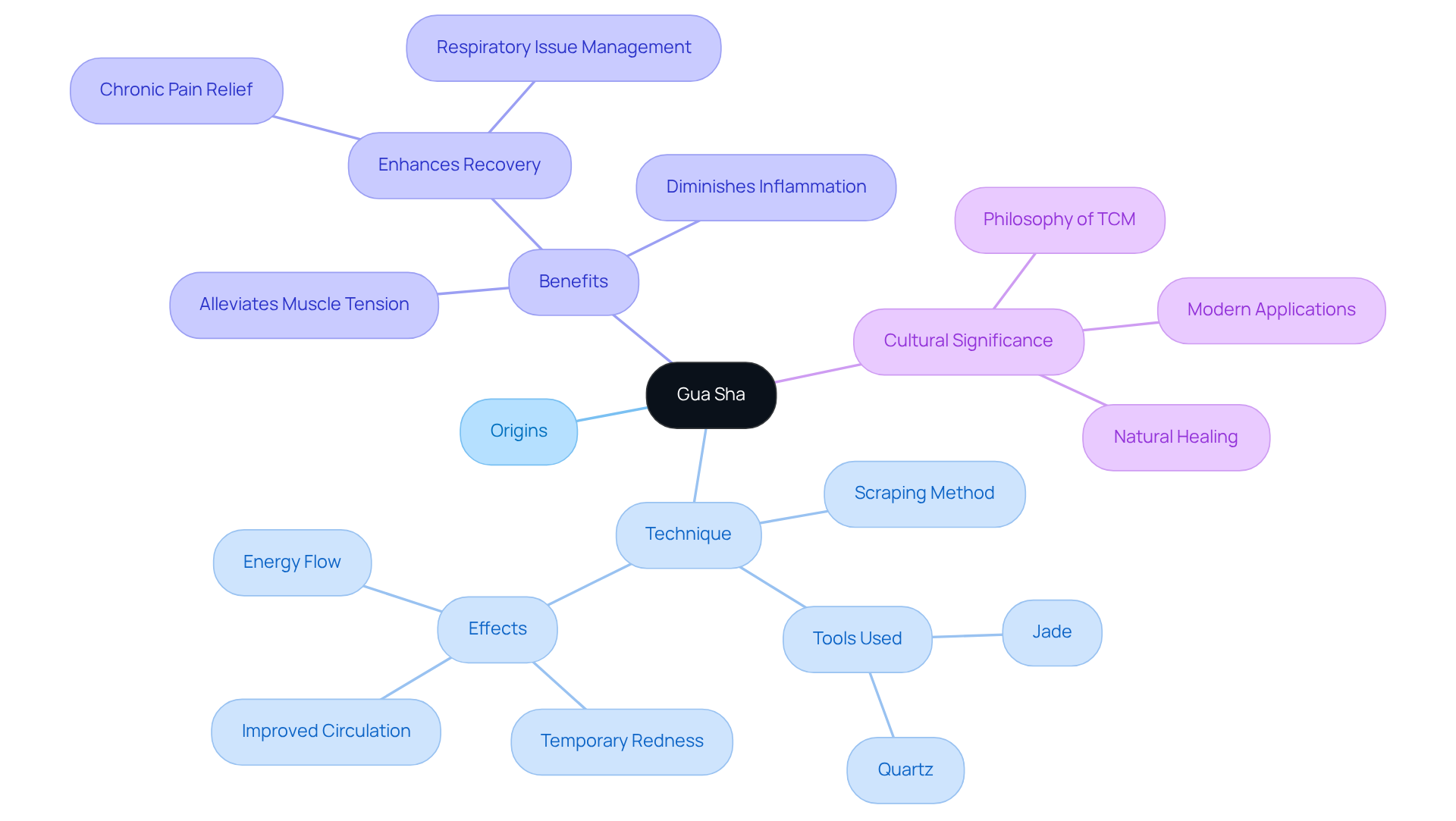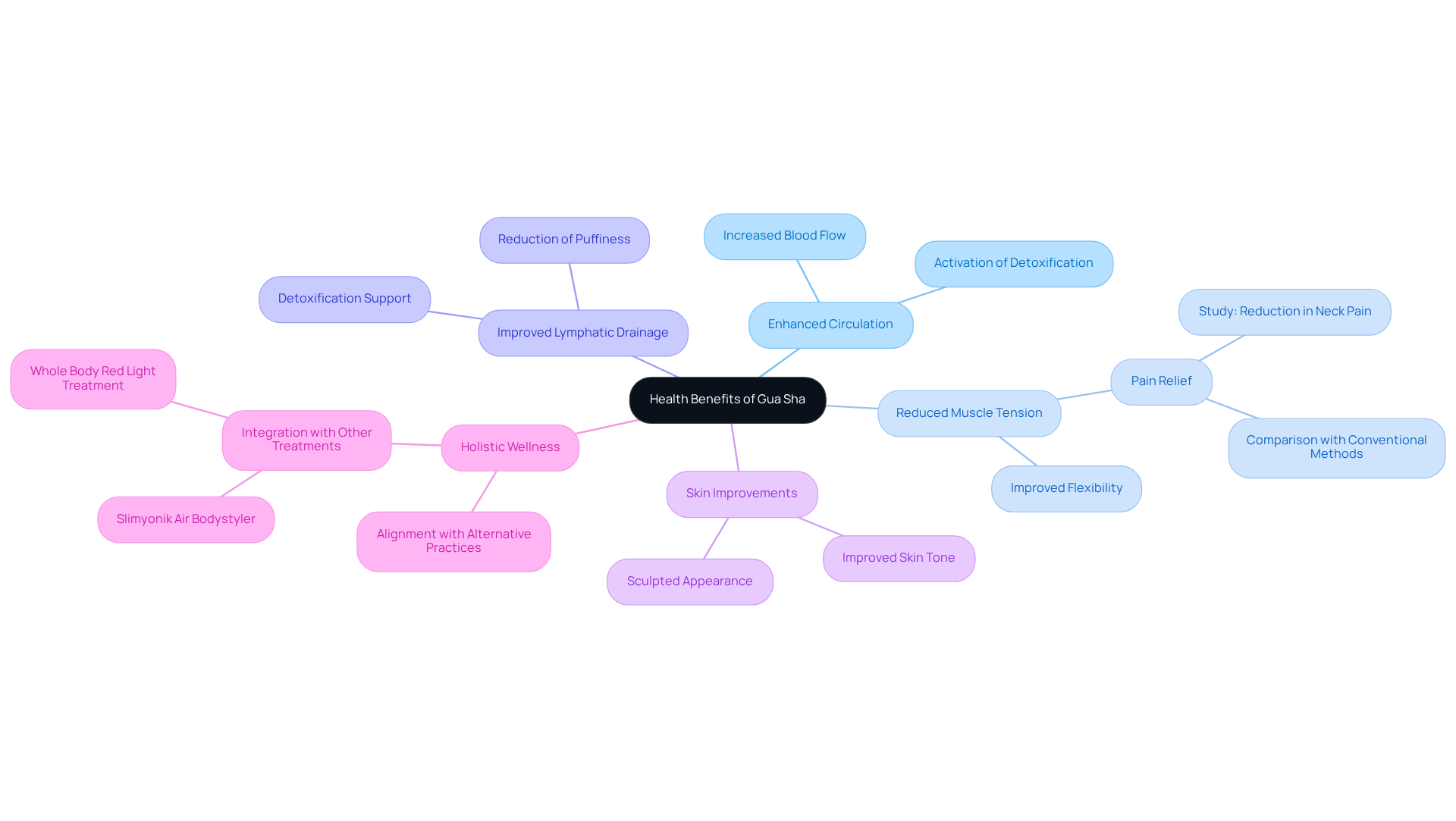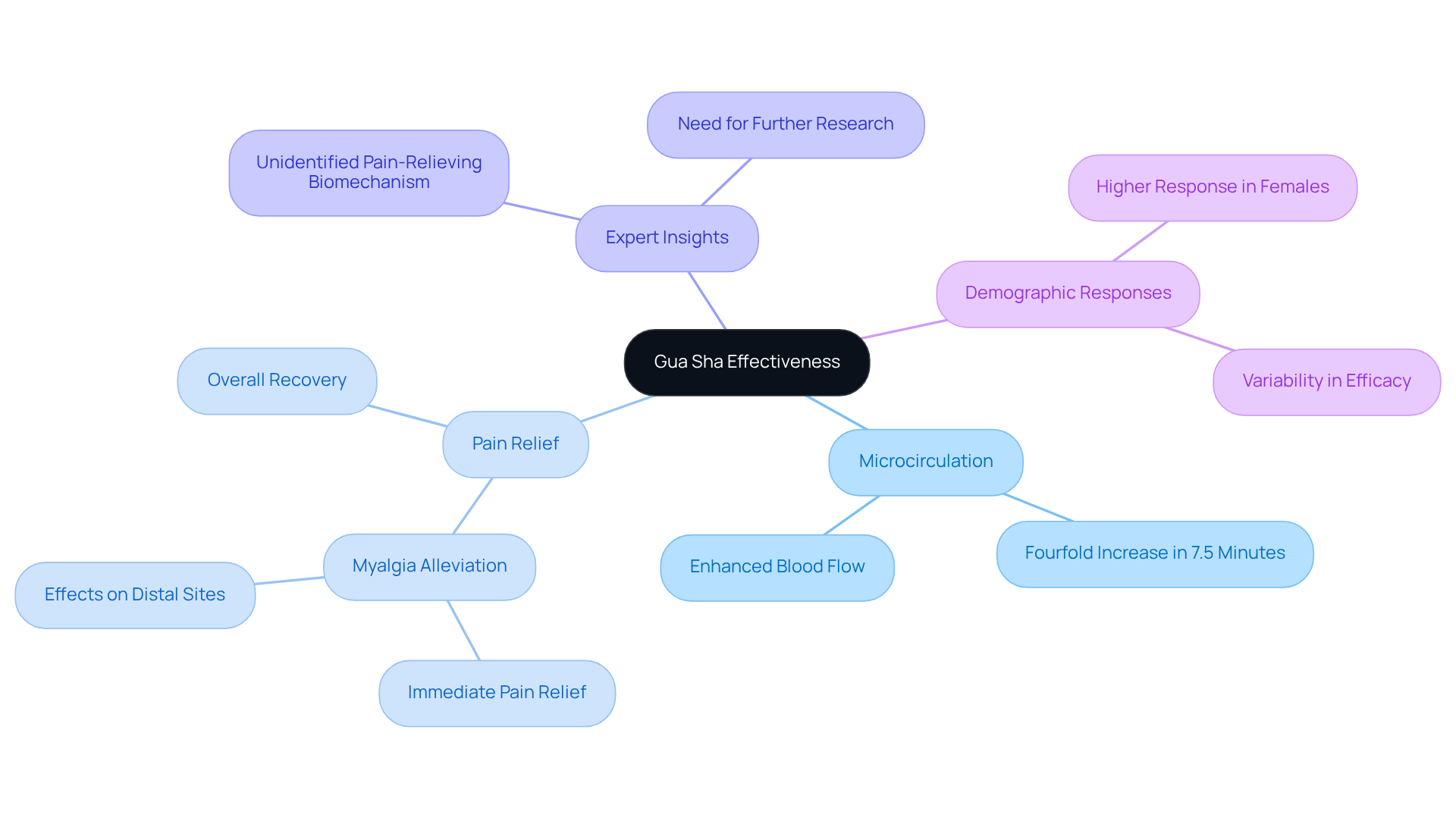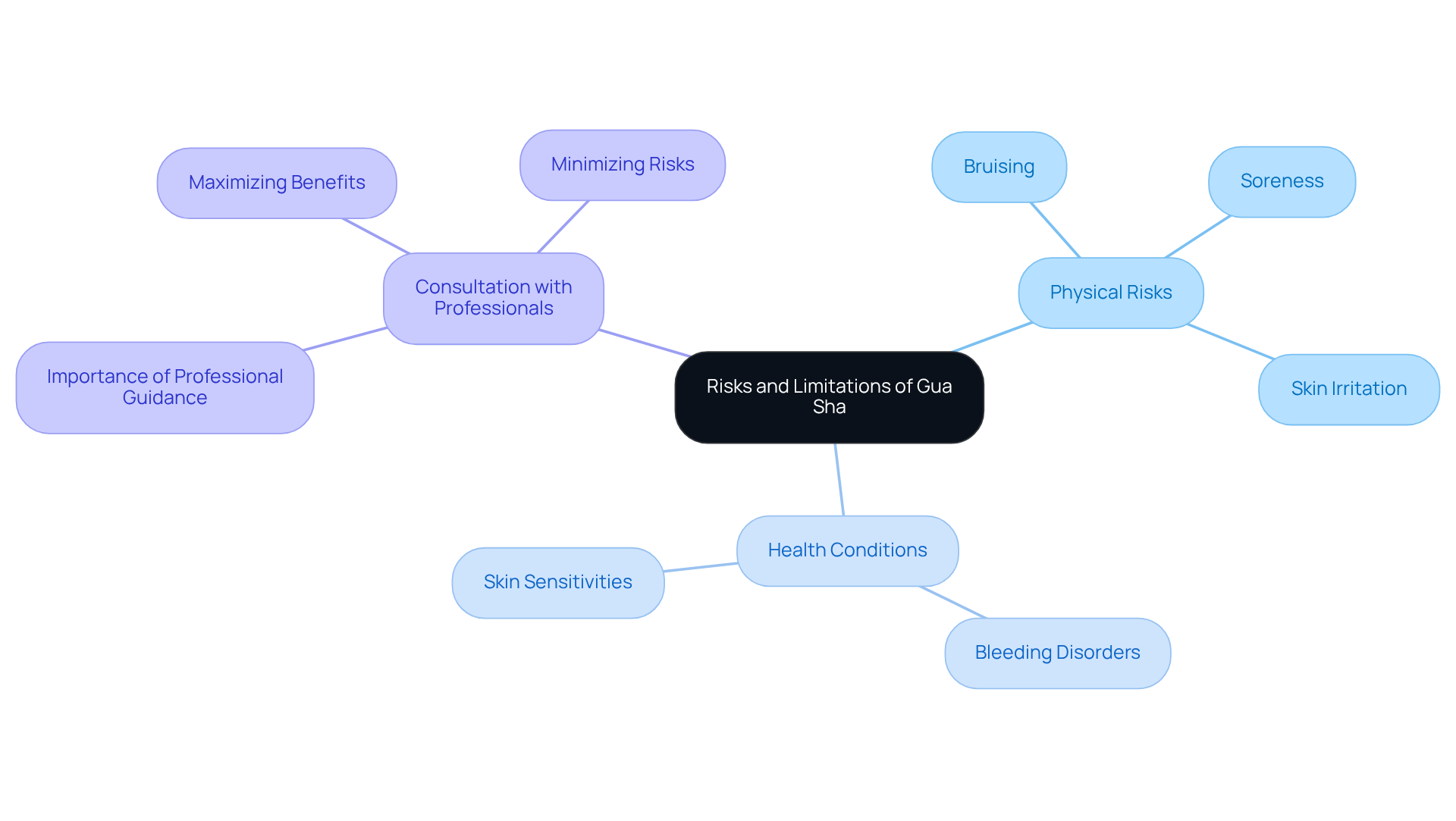Does Gua Sha Work? Uncovering Its Benefits and Science

Overview
Gua Sha stands out as an effective method for enhancing circulation, alleviating muscle tension, and improving overall well-being. Research substantiates these claims, demonstrating significant pain relief and increased microcirculation following treatment. Studies illustrate Gua Sha's remarkable ability to trigger healing responses within the body, contributing to its growing popularity in both wellness and beauty sectors.
However, it is essential to acknowledge the necessity for further research to fully understand its mechanisms and ensure safe practice. As interest in Gua Sha continues to rise, professionals in the field are encouraged to explore its potential benefits while remaining vigilant about safety and efficacy.
Introduction
Gua Sha, an ancient practice rooted in Traditional Chinese Medicine, has resurfaced as a compelling holistic treatment, captivating those in pursuit of natural wellness solutions. This technique, which involves the gentle scraping of the skin with smooth-edged tools, promises a range of health benefits—from improved circulation to reduced muscle tension.
As its popularity grows, the critical question arises: does Gua Sha truly deliver on its claims, or is it merely a fleeting trend? Delving into the science and testimonials surrounding this age-old method reveals both its potential advantages and the considerations one must keep in mind.
It is essential for those considering Gua Sha to evaluate its efficacy based on credible evidence and personal experiences.
Define Gua Sha: Origins and Technique
, a time-honored healing technique rooted in (TCM), involves the meticulous scraping of the skin using a smooth-edged tool, typically fashioned from jade or quartz. This ancient practice, utilized for centuries, is believed to invigorate the flow of 'qi' (energy) and . By applying precise pressure to the skin, Gua Sha induces temporary redness or bruising—key indicators of and energy flow.
Commonly applied to both the face and body, Gua Sha is esteemed for its capacity to alleviate , diminish inflammation, and from various ailments. This emphasizes the critical importance of balance and inherent in TCM. Recent studies substantiate that Gua Sha does work by significantly enhancing recovery times and alleviating pain levels, with practitioners frequently noting its efficacy in addressing chronic pain and respiratory issues.
The cultural significance of Gua Sha is profound, embodying a broader philosophy within TCM that champions the body's innate capacity for self-healing. As interest in alternative therapies swells, Gua Sha is increasingly recognized, not only for its historical roots but also for its practical applications in contemporary wellness practices. Embracing Gua Sha may well be a pivotal step towards harnessing the body's potential.

Examine the Health Benefits of Gua Sha
Gua Sha is recognized for its myriad health benefits, leading many to wonder, for , reduced muscle tension, and improved lymphatic drainage? At Tsavo Wellness, we align these advantages seamlessly with our advanced treatments, meticulously designed to activate your body’s innate detoxification capabilities. Research underscores that while many wonder if does gua sha work, it can trigger the release of healing chemicals, alleviate pain, and reduce inflammation. A pivotal study published in the Journal of Pain Medicine revealed that Gua Sha treatment led to a substantial reduction in neck pain intensity when compared to conventional methods. Moreover, users frequently report improvements in skin tone, reduced puffiness, and a more sculpted appearance, raising the question of does gua sha work, which contributes to its rising popularity in the beauty and wellness sectors.
The holistic approach of Gua Sha has led many to wonder, does gua sha work, as it resonates with the increasing trend of incorporating alternative practices into personal wellness routines, attracting individuals in search of . This technique not only addresses physical discomfort but also aligns with our broader , complemented by our such as the Slimyonik Air Bodystyler and . Clients have shared , highlighting how these treatments have significantly improved their well-being, further reinforcing the effectiveness of our holistic approach.

Explore the Science Behind Gua Sha's Effectiveness
Gua Sha, a traditional East Asian healing method, has garnered significant attention for its potential health benefits, raising the question of whether does —an essential factor for cellular restoration and overall performance improvement. Recent studies raise the question of how well does gua sha work, revealing that it can induce an impressive fourfold increase in microcirculation within just 7.5 minutes post-treatment, markedly enhancing blood flow to targeted areas. This elevation in microcirculation is crucial, as it not only facilitates the transport of oxygen and nutrients but also plays a vital role in alleviating muscle soreness and promoting recovery. This aligns seamlessly with the offered at , including and .
A comprehensive analysis involving 765 participants across nine randomized controlled trials demonstrated that , raising the question of does gua sha work, with participants reporting immediate pain relief at both the treated site and adjacent areas. This suggests that the question of whether does gua sha work extends beyond localized treatment, potentially influencing and enhancing health and vitality—key components of the at Tsavo Wellness.
Expert insights further bolster these findings. Arya Nielsen, PhD, highlights an unidentified pain-relieving biomechanism linked to Gua Sha. Furthermore, Gua Sha may modulate inflammatory responses and elevate serotonin precursor levels in the bloodstream, which could enhance mood and overall well-being. However, while preliminary evidence is promising, experts stress the need for more rigorous clinical trials to clarify the underlying mechanisms and establish standardized treatment protocols.
Interestingly, research indicates that females exhibit compared to males, underscoring the necessity for a nuanced understanding of its efficacy across different demographics. As research evolves, the inquiry into whether does gua sha work in improving microcirculation and alleviating muscle soreness is increasingly acknowledged, positioning it as a valuable adjunct in holistic wellness practices. In summary, while Gua Sha presents promising advantages, ongoing research is vital to fully comprehend its mechanisms and optimize its application, reinforcing Tsavo Wellness's commitment to enhancing well-being through advanced therapies.

Consider Risks and Limitations of Gua Sha
While , it is crucial to recognize the . This technique may lead to bruising, soreness, and, in some instances, , particularly if executed incorrectly or with excessive pressure. Individuals with specific , including bleeding disorders or skin sensitivities, must consult a healthcare professional prior to attempting Gua Sha.
Although many users report positive outcomes, the for more comprehensive studies to fully ascertain whether Gua Sha does work in terms of its efficacy and safety. Therefore, it is imperative for individuals to , ensuring they are well-informed and guided by . This approach maximizes benefits while minimizing risks.

Conclusion
Gua Sha represents a powerful embodiment of traditional healing practices, seamlessly merging ancient wisdom with contemporary wellness. Rooted in Traditional Chinese Medicine, this technique not only enhances circulation and alleviates muscle tension but also fosters the body's inherent healing processes. As the pursuit of holistic health gains momentum, Gua Sha stands out as a compelling choice for those seeking natural, non-invasive treatments.
The exploration of Gua Sha reveals that its advantages extend far beyond superficial benefits. This practice is associated with improved microcirculation, pain relief, and even elevated mood through its positive effects on inflammatory responses. Scientific studies substantiate these assertions, demonstrating notable advancements in pain management and recovery times, while testimonials from users reinforce its effectiveness in promoting overall well-being. Nevertheless, it is crucial to approach Gua Sha with an understanding of its potential risks and the necessity of professional guidance.
Embracing Gua Sha may well be a transformative step toward enhanced health. As this ancient practice garners increasing recognition within modern wellness circles, individuals are urged to consider its potential benefits while remaining informed about its application and limitations. By incorporating Gua Sha into personal health routines, one can unlock a pathway to rejuvenation and balance, honoring the body’s innate capacity for self-healing.
Frequently Asked Questions
What is Gua Sha?
Gua Sha is a traditional healing technique from Traditional Chinese Medicine (TCM) that involves scraping the skin with a smooth-edged tool, typically made from jade or quartz, to invigorate the flow of 'qi' (energy) and enhance overall health.
What are the origins of Gua Sha?
Gua Sha has its roots in Traditional Chinese Medicine, where it has been practiced for centuries as a method of promoting healing and balance within the body.
How does Gua Sha work?
Gua Sha works by applying precise pressure to the skin, which can induce temporary redness or bruising, indicating improved circulation and energy flow. This technique is believed to alleviate muscle tension, reduce inflammation, and accelerate recovery from various ailments.
What are the benefits of Gua Sha?
Gua Sha is known for its ability to relieve muscle tension, diminish inflammation, and improve recovery times. It is particularly noted for its effectiveness in addressing chronic pain and respiratory issues.
Is there scientific evidence supporting Gua Sha?
Yes, recent studies have shown that Gua Sha can significantly enhance recovery times and alleviate pain levels, supporting its efficacy as a therapeutic practice.
What is the cultural significance of Gua Sha?
Gua Sha holds profound cultural significance within TCM, embodying a philosophy that emphasizes the body's innate capacity for self-healing and the importance of balance and natural healing methods.
How is Gua Sha applied in contemporary wellness practices?
As interest in alternative therapies grows, Gua Sha is increasingly recognized for its historical roots and practical applications in modern wellness, helping individuals harness their body's natural healing potential.


